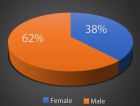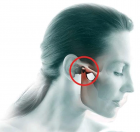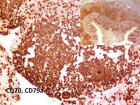Abstract
Research Article
Development of ELISA based detection system against C. botulinum type B
Arti Sharma* and S Ponmariappan
Published: 30 March, 2020 | Volume 3 - Issue 1 | Pages: 017-020
Botulism is the disease caused by botulinum neurotoxins. It is produced by an obligate anaerobic bacteria called Clostridium botulinum. There is no immuno-detection system available in the world for the detection of C. botulinum. Secretory proteins of cooked meat media grown C. botulinum type B were extracted by TCA precipitation method. Polyclonal antibodies were generated against secretory proteins. Cytokine profiling of secretory proteins were done. An immunodetection system was developed to detect the C. botulinum type B using Secretory proteins of C. botulinum type B.
Read Full Article HTML DOI: 10.29328/journal.ijcmbt.1001010 Cite this Article Read Full Article PDF
Keywords:
Anaerobic; Botulism; ELISA; Centrifugation; Antiserum
References
- Agarwal AK, Goel A, Kohli A, Rohtagi A, Kumar R. Food-borne botulism. J Assoc Physicians India. 2004; 52: 677-678. PubMed: https://www.ncbi.nlm.nih.gov/pubmed/15847370
- Chaudhry R, Dhawan VB, Kumar D, Bhatia R, Gandhi JC, et al. Outbreak of suspected Clostridium butyricum botulism in India. Emerg Infect Dis. 1998; 4: 506-507. PubMed: https://www.ncbi.nlm.nih.gov/pmc/articles/PMC2640317/
- Fillo S, Giordani F, Anselmo A, Fortunato A, Palozzi AM, et al. Draft genome sequence of Clostridium botulinum B2 450 strain from wound botulism in a drug user in Italy. Genome Announc. 2015; 3: e00238-15. PubMed: https://www.ncbi.nlm.nih.gov/pubmed/25838491
- de Jong LI, Fernández RA, Pareja V, Giaroli G, Guidarelli SR, et al. First report of an infant botulism case due to Clostridium botulinum type Af, J Clin Microbiol.2015; 53: 740-742. PubMed: https://www.ncbi.nlm.nih.gov/pubmed/25502535
- MacDonald E, Arnesen TM, Brantsaeter AB, Gerlyng P, Grepp M, et al. Outbreak of wound botulism in people who inject drugs, Norway, October to November 2013, Euro Surveill. 2013; 18: 20630. PubMed: https://www.ncbi.nlm.nih.gov/pubmed/24229788
- Hernández-de Mezerville M, Rojas-Solano M, Gutierrez-Mata A, Hernández-Con L, Ulloa-Gutierrez R et al. Infant botulism in Costa Rica: first report from Central America. J Infect Dev Ctries. 2014; 8: 123-125. PubMed: https://www.ncbi.nlm.nih.gov/pubmed/24423723
- Kautter DA, Solomon HM. Collaborative study of a method for the detection of Clostridium botulinum and its toxins in foods. J Assoc Off Anal Chem. 1977; 60: 541-545. PubMed: https://www.ncbi.nlm.nih.gov/pubmed/323214
- Cai S, Singh BR, Sharma S. Botulism diagnostics: from clinical symptoms to in vitro assays. Crit Rev Microbiol. 2007; 33: 109-125. PubMed: https://www.ncbi.nlm.nih.gov/pubmed/17558660
- Lindström M, Keto R, Markkula A, Nevas M, Hielm S, et al, Multiplex PCR assay for detection and identification of Clostridium botulinum types A, B, E, and F in food and fecal material. Appl Environ Microbiol. 2001; 67: 5694-5699. PubMed: https://www.ncbi.nlm.nih.gov/pubmed/11722924
- Sharma A, Ponmariappan S, Sarita R, Alam SI, Kamboj DV, et al. Identification of Cross Reactive Antigens of C. botulinum Types A, B, E & F by Immunoproteomic Approach. Curr Microbiol. 2018; 75: 531-540. PubMed: https://www.ncbi.nlm.nih.gov/pubmed/29332140
- Doellgast GJ, Beard GA, Bottoms JD, Cheng T, Roh BH, et al. Enzyme-linked immunosorbent assay-enzyme-linked coagulation assay for detection of antibodies to Clostridium botulinum neurotoxins A, B, and E and solution-phase complexes. J Clin Microbiol. 1994; 32: 105-111. PubMed: https://www.ncbi.nlm.nih.gov/pubmed/8126163
- Szílagyi M, Rivera VR, Neal D, Merrill GA, Poli MA. Development of sensitive colorimetric capture elisas for Clostridium botulinum neurotoxin serotypes A and B. Toxicon. 2000; 38: 381-389. PubMed: https://www.ncbi.nlm.nih.gov/pubmed/10669027
- Ferreira JL, Eliasberg SJ, Harrison MA, Edmonds P. Edmonds, Detection of preformed type A botulinal toxin in hash brown potatoes by using the mouse bioasssay and a modified ELISA test. J AOAC Int. 2001; 84: 1460-1464. PubMed: https://www.ncbi.nlm.nih.gov/pubmed/11601465
- Teixeira LK, Fonseca BP, Barboza BA, Viola JP. The role of interferon-gamma on immune and allergic responses, Mem Inst Oswaldo Cruz. 2005; 100: 137-144. PubMed: https://www.ncbi.nlm.nih.gov/pubmed/15962113
- Codarri L, Gyülvészi G, Tosevski V, Hesske L, Fontana A, et al. ROR [gamma] t drives production of the cytokine GM-CSF in helper T cells, which is essential for the effector phase of autoimmune neuroinflammation. Nat Immunol. 2011; 12: 560-567. PubMed: https://www.ncbi.nlm.nih.gov/pubmed/21516112
- Sachan M, Agarwal RK, A simple enzyme-linked immunosorbent assay for the detection of Aeromonas spp. Veterinarski Arhiv. 2002; 72: 327-334.
- Lee HA, Wyatt GM, Bramham S, Morgan MR. Enzyme-linked immunosorbent assay for Salmonella typhimurium in food: feasibility of 1-day Salmonella detection. Appl Environ Microbiol. 1990; 56: 1541-1546. PubMed: https://www.ncbi.nlm.nih.gov/pubmed/2200337
- Merino S, Camprubí S, Tomás JM. Detection of Aeromonas hydrophila in food with an enzyme‐linked immunosorbent assay. J Appl Bacteriol. 1993; 74: 149-154. PubMed: https://www.ncbi.nlm.nih.gov/pubmed/8444644
Figures:

Figure 1

Figure 2

Figure 3
Similar Articles
-
Development of ELISA based detection system against C. botulinum type BArti Sharma*,S Ponmariappan. Development of ELISA based detection system against C. botulinum type B. . 2020 doi: 10.29328/journal.ijcmbt.1001010; 3: 017-020
-
Incidence of hepatitis B and hepatitis C in Pediatric ward in 2ed March teaching hospital, Sebha: South of LibyaIdress H Attitalla*,Shaban R Bagar,Marei A Altayar,Abdlmanam Fakron,Hosam B Bahnosy. Incidence of hepatitis B and hepatitis C in Pediatric ward in 2ed March teaching hospital, Sebha: South of Libya. . 2021 doi: 10.29328/journal.ijcmbt.1001022; 4: 028-031
-
Association between clinical forms of Leprosy and contacts with the vaccination state with BCG in five endemic municipalities in the Brazilian AmazonMaria do Perpétuo Socorro Amador Silvestre*,Maxwell Furtado de Lima,E Luana Nepomuceno Gondim Costa Lima. Association between clinical forms of Leprosy and contacts with the vaccination state with BCG in five endemic municipalities in the Brazilian Amazon. . 2022 doi: 10.29328/journal.ijcmbt.1001024; 5: 001-004
Recently Viewed
-
Sinonasal Myxoma Extending into the Orbit in a 4-Year Old: A Case PresentationJulian A Purrinos*, Ramzi Younis. Sinonasal Myxoma Extending into the Orbit in a 4-Year Old: A Case Presentation. Arch Case Rep. 2024: doi: 10.29328/journal.acr.1001099; 8: 075-077
-
Timing of cardiac surgery and other intervention among children with congenital heart disease: A review articleChinawa JM*,Adiele KD,Ujunwa FA,Onukwuli VO,Arodiwe I,Chinawa AT,Obidike EO,Chukwu BF. Timing of cardiac surgery and other intervention among children with congenital heart disease: A review article. J Cardiol Cardiovasc Med. 2019: doi: 10.29328/journal.jccm.1001047; 4: 094-099
-
Advancing Forensic Approaches to Human Trafficking: The Role of Dental IdentificationAiswarya GR*. Advancing Forensic Approaches to Human Trafficking: The Role of Dental Identification. J Forensic Sci Res. 2025: doi: 10.29328/journal.jfsr.1001076; 9: 025-028
-
Scientific Analysis of Eucharistic Miracles: Importance of a Standardization in EvaluationKelly Kearse*,Frank Ligaj. Scientific Analysis of Eucharistic Miracles: Importance of a Standardization in Evaluation. J Forensic Sci Res. 2024: doi: 10.29328/journal.jfsr.1001068; 8: 078-088
-
Toxicity and Phytochemical Analysis of Five Medicinal PlantsJohnson-Ajinwo Okiemute Rosa*, Nyodee, Dummene Godwin. Toxicity and Phytochemical Analysis of Five Medicinal Plants. Arch Pharm Pharma Sci. 2024: doi: 10.29328/journal.apps.1001054; 8: 029-040
Most Viewed
-
Evaluation of Biostimulants Based on Recovered Protein Hydrolysates from Animal By-products as Plant Growth EnhancersH Pérez-Aguilar*, M Lacruz-Asaro, F Arán-Ais. Evaluation of Biostimulants Based on Recovered Protein Hydrolysates from Animal By-products as Plant Growth Enhancers. J Plant Sci Phytopathol. 2023 doi: 10.29328/journal.jpsp.1001104; 7: 042-047
-
Sinonasal Myxoma Extending into the Orbit in a 4-Year Old: A Case PresentationJulian A Purrinos*, Ramzi Younis. Sinonasal Myxoma Extending into the Orbit in a 4-Year Old: A Case Presentation. Arch Case Rep. 2024 doi: 10.29328/journal.acr.1001099; 8: 075-077
-
Feasibility study of magnetic sensing for detecting single-neuron action potentialsDenis Tonini,Kai Wu,Renata Saha,Jian-Ping Wang*. Feasibility study of magnetic sensing for detecting single-neuron action potentials. Ann Biomed Sci Eng. 2022 doi: 10.29328/journal.abse.1001018; 6: 019-029
-
Pediatric Dysgerminoma: Unveiling a Rare Ovarian TumorFaten Limaiem*, Khalil Saffar, Ahmed Halouani. Pediatric Dysgerminoma: Unveiling a Rare Ovarian Tumor. Arch Case Rep. 2024 doi: 10.29328/journal.acr.1001087; 8: 010-013
-
Physical activity can change the physiological and psychological circumstances during COVID-19 pandemic: A narrative reviewKhashayar Maroufi*. Physical activity can change the physiological and psychological circumstances during COVID-19 pandemic: A narrative review. J Sports Med Ther. 2021 doi: 10.29328/journal.jsmt.1001051; 6: 001-007

HSPI: We're glad you're here. Please click "create a new Query" if you are a new visitor to our website and need further information from us.
If you are already a member of our network and need to keep track of any developments regarding a question you have already submitted, click "take me to my Query."


















































































































































